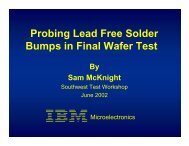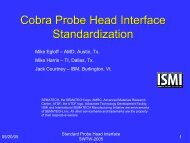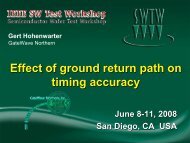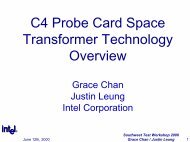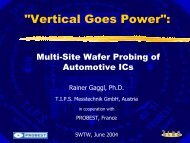SWTW 2003 - Wentworth Laboratories - Semiconductor Wafer Test ...
SWTW 2003 - Wentworth Laboratories - Semiconductor Wafer Test ...
SWTW 2003 - Wentworth Laboratories - Semiconductor Wafer Test ...
You also want an ePaper? Increase the reach of your titles
YUMPU automatically turns print PDFs into web optimized ePapers that Google loves.
Presentation to<br />
Southwest <strong>Test</strong> Workshop <strong>2003</strong><br />
Off-Line Chemical Cleaning Technology<br />
for Removal of Solder Contaminant from<br />
Cobra ® Vertical Technology Probe Tips<br />
Bill Fulton<br />
<strong>Wentworth</strong><br />
<strong>Laboratories</strong>
Overview<br />
1. Challenges for Chemical Cleaning<br />
2. Variables<br />
3. Benefits of new ProbeWash Chemical Cleaning<br />
Technology*<br />
4. Components of ProbeWash Assembly<br />
5. <strong>Test</strong> Results<br />
6. Performance<br />
7. ProbeWash Roadmap<br />
8. Conclusions<br />
9. Appendix: Terminology/Acronyms<br />
* Patent Pending<br />
<strong>SWTW</strong> <strong>2003</strong> - <strong>Wentworth</strong> <strong>Laboratories</strong> 2
Chemical Cleaning Challenges<br />
Develop chemical cleaning technology that:<br />
• Is specifically for Cobra vertical contact technology<br />
• Removes solder contaminate from probe tip<br />
• Works quickly for minimal downtime<br />
• Is non-destructive/non-abrasive<br />
• Delivers consistent performance for repeatable results<br />
• Limits chemical exposure of CH to tips only<br />
• Is easy-to-use and requires minimal training<br />
• Has no special facility requirements<br />
<strong>SWTW</strong> <strong>2003</strong> - <strong>Wentworth</strong> <strong>Laboratories</strong> 3
Development Considerations<br />
• Efficacy of Chemistry<br />
• Probe Material<br />
• Type of Contaminant<br />
• Exposure Time<br />
• Control of Probe Tip Penetration<br />
<strong>SWTW</strong> <strong>2003</strong> - <strong>Wentworth</strong> <strong>Laboratories</strong> 4
Existing Off-Line Cleaning Method for Solder<br />
Contaminate on Cobra Contact<br />
IPA Wash and Brush<br />
New Probe<br />
<strong>SWTW</strong> <strong>2003</strong> - <strong>Wentworth</strong> <strong>Laboratories</strong> 5
Why IPA Wash/Brush Doesn’t Work<br />
1. Solder accumulations result from both mechanical and<br />
electrical transfer phenomenon<br />
Load<br />
Sliding<br />
Asperities interact and adhere<br />
2. Transfer results in a metallic bonding to the probe that<br />
can not be removed by brushing<br />
3. Solder accumulation can not be removed with solvents –<br />
such as IPA – must be chemically reduced<br />
<strong>SWTW</strong> <strong>2003</strong> - <strong>Wentworth</strong> <strong>Laboratories</strong> 6
Benefits of ProbeWash Technology<br />
• Removes solder (SnPb) contaminate<br />
• Reduces C Res<br />
• Has potential to extend test cycles<br />
between cleaning<br />
• Improves planarity measurement<br />
• Optimally two minute exposure time<br />
• Non-abrasive for longer probe life<br />
<strong>SWTW</strong> <strong>2003</strong> - <strong>Wentworth</strong> <strong>Laboratories</strong> 7
Benefits of ProbeWash Technology<br />
• Pre-loaded<br />
chemical cartridge<br />
calibration<br />
• Chemistry only<br />
contacts probes<br />
Pre-loaded chemical cartridge<br />
• Fixture design<br />
prevents probe<br />
damage<br />
<strong>SWTW</strong> <strong>2003</strong> - <strong>Wentworth</strong> <strong>Laboratories</strong> 8
Benefits of ProbeWash Technology<br />
• Clean Room Compatible<br />
• Safe<br />
– All contaminants retained in pad<br />
– Disposable cartridge<br />
– No spills or odors<br />
• Compact/Portable<br />
– Weighs 4.9 lbs.<br />
– Small footprint – 6”w x 12”l x 4”h<br />
<strong>SWTW</strong> <strong>2003</strong> - <strong>Wentworth</strong> <strong>Laboratories</strong> 9
ProbeWash Assembly<br />
Spring loaded fasteners for CH<br />
Seat for<br />
CH<br />
Seat for<br />
chemical<br />
cartridge<br />
Alignment<br />
Guides<br />
Overcentering<br />
hinge<br />
Pre-loaded chemical cartridge<br />
Insertion of chemical cartridge<br />
<strong>SWTW</strong> <strong>2003</strong> - <strong>Wentworth</strong> <strong>Laboratories</strong> 10
ProbeWash Assembly<br />
Open chemical<br />
cartridge<br />
Lift and rotate<br />
mounting bracket<br />
Closed<br />
assembly in<br />
cleaning<br />
position<br />
<strong>SWTW</strong> <strong>2003</strong> - <strong>Wentworth</strong> <strong>Laboratories</strong> 11
Pre-Loaded Chemical Cartridge<br />
Probe penetration controlled by cartridge<br />
Rim size above the pad controls the<br />
probe penetration depth into the pad.<br />
Absorbent pad retains contaminants<br />
removed from the probe tips.<br />
<strong>SWTW</strong> <strong>2003</strong> - <strong>Wentworth</strong> <strong>Laboratories</strong> 12
4 mil BeCu Probe with Rh and Pd Plating<br />
Before ProbeWash<br />
After ProbeWash<br />
SnPb<br />
Contaminate<br />
<strong>SWTW</strong> <strong>2003</strong> - <strong>Wentworth</strong> <strong>Laboratories</strong> 13
SEM - New BeCu Probe with Rh and Pd<br />
Plating<br />
<strong>SWTW</strong> <strong>2003</strong> - <strong>Wentworth</strong> <strong>Laboratories</strong> 14
SEM Analysis – After 250M Touchdowns<br />
Before ProbeWash<br />
After ProbeWash<br />
<strong>SWTW</strong> <strong>2003</strong> - <strong>Wentworth</strong> <strong>Laboratories</strong> 15
SEM Analysis Synopsis<br />
Weight %<br />
Probe Materials/Contaminates<br />
<strong>SWTW</strong> <strong>2003</strong> - <strong>Wentworth</strong> <strong>Laboratories</strong> 16
Performance CRes<br />
• JMP analysis indicates statistical difference in<br />
the before and after results to a 99.5%<br />
confidence.<br />
• No statistical difference between after and the<br />
outgoing C Res for this head.<br />
• Statistically as good as new.<br />
Cres<br />
20<br />
15<br />
10<br />
Means Comparisons<br />
Dif=Mean[i]-Mean[j]<br />
Before<br />
After<br />
Initial<br />
Alpha= 0.01<br />
Before After Initial<br />
0.0000 4.7459 4.8120<br />
-4.7459<br />
-4.8120<br />
0.0000<br />
-0.0661<br />
0.0661<br />
0.0000<br />
Comparisons for all pairs using Tukey-Kramer HSD<br />
q*<br />
3.15052<br />
Before<br />
After<br />
Initial<br />
Alpha<br />
-1.4832<br />
0.005<br />
Abs(Dif)-LSD<br />
Before After Initial<br />
3.2597<br />
3.3288<br />
3.2597<br />
-1.4892<br />
-1.4201<br />
3.3288<br />
-1.4201<br />
-1.4832<br />
Positive values show pairs of means that are significantly different.<br />
5<br />
Level<br />
Mean<br />
0<br />
After Before Initial<br />
Cres Type<br />
All Pairs<br />
Tukey-Kramer<br />
0.005<br />
Before<br />
After<br />
Initial<br />
A<br />
B<br />
B<br />
7.9440291<br />
3.1980820<br />
3.1320238<br />
Levels not connected by same letter are significantly different<br />
<strong>SWTW</strong> <strong>2003</strong> - <strong>Wentworth</strong> <strong>Laboratories</strong> 17
Oneway Analysis<br />
of Good Die<br />
Oneway Analysis of Good By Cleaning Process<br />
160<br />
150<br />
Good<br />
140<br />
• JMP analysis indicates a significant<br />
statistical difference between the<br />
before clean and after clean with<br />
respect to the number of good die<br />
tested.<br />
• JMP analysis indicates an increase<br />
in the number of good die tested for<br />
each wafer.<br />
130<br />
ProbeWash Clean<br />
No Clean<br />
No Clean<br />
Means Comparisons<br />
Cleaning Process<br />
Dif=Mean[i]-Mean[j]<br />
ProbeWash Clean<br />
Alpha= 0.01<br />
0.0000<br />
-2.6365<br />
ProbeWash Clean<br />
No Clean<br />
2.6365<br />
0.0000<br />
Comparisons for all pairs using Tukey-Kramer HSD<br />
q* Alpha<br />
2.58298<br />
Abs(Dif)-LSD<br />
ProbeWash Clean<br />
No Clean<br />
0.01<br />
ProbeWash Clean<br />
-2.5906<br />
0.1251<br />
No Clean<br />
0.1251<br />
-2.4296<br />
All Pairs<br />
Tukey-Kramer<br />
0.01<br />
Positive values show pairs of means that are significantly different.<br />
ProbeWash Clean<br />
No Clean<br />
<strong>SWTW</strong> <strong>2003</strong> - <strong>Wentworth</strong> <strong>Laboratories</strong> 18<br />
Level<br />
A<br />
B<br />
Mean<br />
147.28571<br />
144.64921<br />
Levels not connected by same letter are significantly different
Oneway Analysis<br />
of Open Channels<br />
Oneway Analysis of Open By Cleaning Process<br />
Open<br />
1<br />
• JMP analysis indicates a significant<br />
statistical difference between the<br />
before clean and after clean with<br />
respect to the number of open<br />
channels tested.<br />
• The data indicates a reduction in the<br />
number of opens.<br />
0<br />
No Clean<br />
Means Comparisons<br />
Dif=Mean[i]-Mean[j]<br />
No Clean<br />
ProbeWash Clean<br />
Alpha= 0.01<br />
Cleaning Process<br />
0.00000<br />
-0.10576<br />
ProbeWash Clean<br />
No CleanProbeWash Clean<br />
0.10576<br />
0.00000<br />
Comparisons for all pairs using Tukey-Kramer HSD<br />
q* Alpha<br />
2.58298<br />
Abs(Dif)-LSD<br />
No Clean<br />
ProbeWash Clean<br />
0.01<br />
No CleanProbeWash Clean<br />
-0.10118<br />
0.00117<br />
0.00117<br />
-0.10789<br />
All Pairs<br />
Tukey-Kramer<br />
0.01<br />
Positive values show pairs of means that are significantly different.<br />
No Clean A<br />
ProbeWash Clean<br />
<strong>SWTW</strong> <strong>2003</strong> - <strong>Wentworth</strong> <strong>Laboratories</strong> 19<br />
Level<br />
B<br />
Mean<br />
0.16230366<br />
0.05654762<br />
Levels not connected by same letter are significantly different
Performance Planarity<br />
Planarity<br />
20X Batch <strong>Test</strong> Average - PB3K<br />
1.5<br />
1<br />
Bef ore ProbeWash<br />
After ProbeWash<br />
( .001" )<br />
0.5<br />
0<br />
-0.5<br />
-1<br />
-1.5<br />
0 20 40 60 80 100 120<br />
Probe<br />
<strong>SWTW</strong> <strong>2003</strong> - <strong>Wentworth</strong> <strong>Laboratories</strong> 20
Conclusion<br />
ProbeWash Chemical Cleaning<br />
Technology enables removal of<br />
solder contaminant from Cobra<br />
vertical probes, restoring performance<br />
characteristics for improved C Res ,<br />
planarity and yield.<br />
<strong>Wentworth</strong><br />
<strong>Laboratories</strong><br />
<strong>SWTW</strong> <strong>2003</strong> - <strong>Wentworth</strong> <strong>Laboratories</strong> 21
Appendix: Terminology/Acronyms<br />
1. ProbeWash –Chemical Cleaning Technology<br />
2. CH – Cobra Head<br />
3. C RES – Contact Resistance<br />
4. SnPb – Tin Lead (components of solder)<br />
5. Al - Aluminum<br />
6. Cu - Copper<br />
7. Pd – Palladium<br />
8. Rh – Rhodium<br />
9. IPA – Isopropyl Alcohol<br />
<strong>SWTW</strong> <strong>2003</strong> - <strong>Wentworth</strong> <strong>Laboratories</strong> 22


